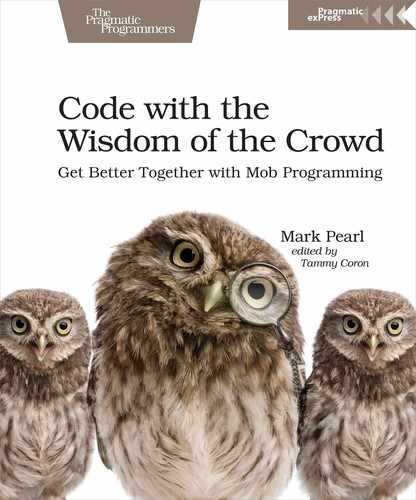Mobbing on Explorative Work
Every now and then you’ll run into situations that have no clear next step for the mob. This is quite common when new technology is being adopted and nobody has used it before, or when you have taken over a system in a tech stack that’s unfamiliar to everyone. This explorative work can often leave you scratching your head wondering what to do next.
What Usually Happens
It’s interesting to watch how inexperienced mobs handle this. First, there’s usually an awkward moment of silence while everyone in the mob waits for someone else to suggest the next steps (everyone is secretly hoping that somebody else knows what to do). Then, as you realize you’re all at the same level, there’s a mad rush of suggestions from different people, with no clear idea on how to proceed.
Why This Is a Bad Idea
When there’s no clear direction on what the mob should do next, it’s easy for things to get out of hand. Individuals in the mob want to try different ideas first which can be confusing and frustrating for the typist, especially when the typist is receiving conflicting requests in quick succession.
What to Do Instead
First, acknowledge the situation for what it is: the mob has a lot of different divergent ideas at play—which is a good thing. In fact, it’s one of the superpowers of mobbing, provided it’s leveraged properly.
To handle the influx of divergent ideas, the mob needs to agree on which idea to try first. The mob can reach this agreement using one of these two techniques: timeboxed explorations or strong mobbing.
Timeboxed Explorations
A timeboxed exploration gives each person in the mob some time to individually explore their idea to gain a deeper understanding of the task at hand. This is often a good technique to use when there’s an online manual that needs to be read or a series of tutorials that need to be done; these sorts of things are often done best on your own.
It works as follows: first, as a mob, clearly identify what you need to understand before you feel you can move forward effectively; this becomes the timebox objective.
Next, as a group, decide on how long the timebox should be; this is best done by everyone sharing how much time they think they need to figure out the objective, once all of the suggestions are put forward, select the smallest proposed period. If all of the proposed timeboxes are longer than 30 minutes, cap the timebox to 30 minutes.
Now, you start the timebox. Each person works on their own trying to figure out the objective. As soon as someone figures it out, they gather the mob and share their findings.
If the timebox lapses, and nobody has figured things out, you still get back together for a brief catch on what you have learned so far. Then, as a mob, you decide if you have enough context to continue as a group or if you need another timebox to continue working on your own, figuring things out.
Now for a quick pro tip: I’ve seen some mobs separate and go back to their own individual desks outside of the mobbing area when doing timeboxed explorations. I recommend not doing this. Instead, remain in the mobbing area but continue to work on your own.
When people go to their own desks, they open themselves up to distractions; someone comes by to ask for help with something else, or an email suddenly needs a reply. A timeboxed exploration isn’t a break from the problem or an opportunity to introduce an unnecessary context switch. It’s a time for focusing on the task at hand, without distraction.
Strong Mobbing
An alternative approach to timeboxed explorations is strong mobbing. Strong mobbing works well when the mob has diverged—when there are various conflicting ideas proposed, and you need to systematically work through these ideas to converge on a solution.
It works as follows: first, as a mob, you nominate someone as the facilitator. The typist moves into command mode, only implementing what the facilitator asks of them, while ignoring everyone else. If the rest of the mob has an idea, they need to take it to the facilitator.
Next, the facilitator gets the mob to collate and clarifies the various suggestions by writing each idea on the whiteboard—the facilitator should do this regardless of how they personally feel about the idea; it’s up to the mob, not the facilitator, to decide which ideas are worth pursuing.
Once all of the ideas are listed, the facilitator gets the mob to answer for each suggestion what assumptions have been made, what is known for certain, and what still needs to be confirmed.
The mob then decides on a plan of attack, which should include asking the following questions:
- Which idea is worth trying first?
- Which idea is easiest to validate?
- Which idea would be quick to eliminate?
Often at this point, some people in the mob will say they know something for certain, while others feel that same thing still needs to be confirmed. It’s up to the facilitator to keep an eye out for when that happens, and to help the mob get alignment; that may mean the facilitator asks for further explanations or even better, gets the typist to write some code to confirm things.
When strong mobbing works well, the unknowns are clarified, people start converging on a solution, and the way forward becomes clear. Once that happens, strong mobbing can end and normal mobbing can resume.
